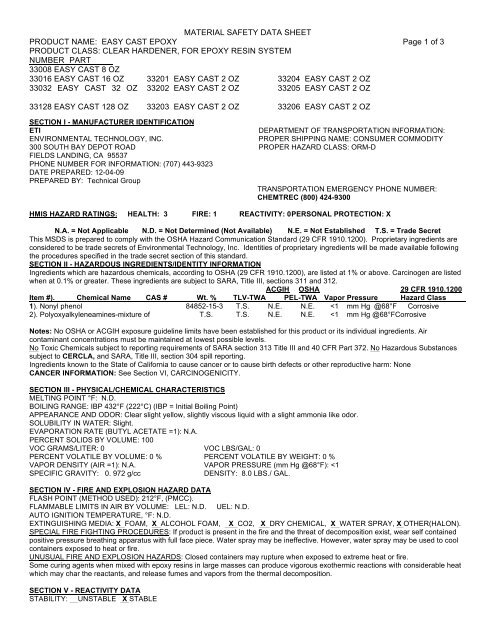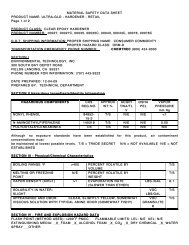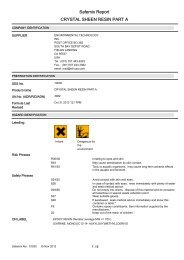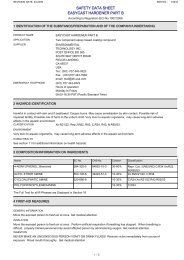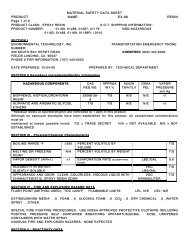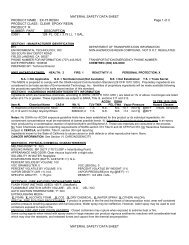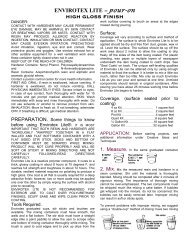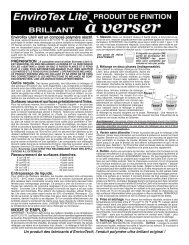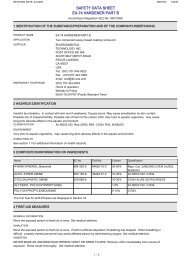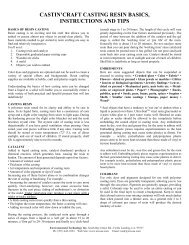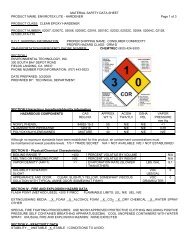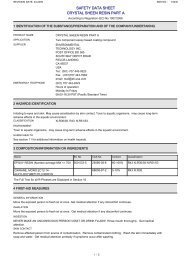MATERIAL SAFETY DATA SHEET PRODUCT NAME: EASY CAST ...
MATERIAL SAFETY DATA SHEET PRODUCT NAME: EASY CAST ...
MATERIAL SAFETY DATA SHEET PRODUCT NAME: EASY CAST ...
Create successful ePaper yourself
Turn your PDF publications into a flip-book with our unique Google optimized e-Paper software.
<strong>MATERIAL</strong> <strong>SAFETY</strong> <strong>DATA</strong> <strong>SHEET</strong><br />
<strong>PRODUCT</strong> <strong>NAME</strong>: <strong>EASY</strong> <strong>CAST</strong> EPOXY Page 1 of 3<br />
<strong>PRODUCT</strong> CLASS: CLEAR HARDENER, FOR EPOXY RESIN SYSTEM<br />
NUMBER PART<br />
33008 <strong>EASY</strong> <strong>CAST</strong> 8 OZ<br />
33016 <strong>EASY</strong> <strong>CAST</strong> 16 OZ 33201 <strong>EASY</strong> <strong>CAST</strong> 2 OZ 33204 <strong>EASY</strong> <strong>CAST</strong> 2 OZ<br />
33032 <strong>EASY</strong> <strong>CAST</strong> 32 OZ 33202 <strong>EASY</strong> <strong>CAST</strong> 2 OZ 33205 <strong>EASY</strong> <strong>CAST</strong> 2 OZ<br />
33128 <strong>EASY</strong> <strong>CAST</strong> 128 OZ 33203 <strong>EASY</strong> <strong>CAST</strong> 2 OZ 33206 <strong>EASY</strong> <strong>CAST</strong> 2 OZ<br />
SECTION I - MANUFACTURER IDENTIFICATION<br />
ETI<br />
DEPARTMENT OF TRANSPORTATION INFORMATION:<br />
ENVIRONMENTAL TECHNOLOGY, INC.<br />
PROPER SHIPPING <strong>NAME</strong>: CONSUMER COMMODITY<br />
300 SOUTH BAY DEPOT ROAD PROPER HAZARD CLASS: ORM-D<br />
FIELDS LANDING, CA 95537<br />
PHONE NUMBER FOR INFORMATION: (707) 443-9323<br />
DATE PREPARED: 12-04-09<br />
PREPARED BY: Technical Group<br />
TRANSPORTATION EMERGENCY PHONE NUMBER:<br />
CHEMTREC (800) 424-9300<br />
HMIS HAZARD RATINGS: HEALTH: 3 FIRE: 1 REACTIVITY: 0 PERSONAL PROTECTION: X<br />
N.A. = Not Applicable N.D. = Not Determined (Not Available) N.E. = Not Established T.S. = Trade Secret<br />
This MSDS is prepared to comply with the OSHA Hazard Communication Standard (29 CFR 1910.1200). Proprietary ingredients are<br />
considered to be trade secrets of Environmental Technology, Inc. Identities of proprietary ingredients will be made available following<br />
the procedures specified in the trade secret section of this standard.<br />
SECTION II - HAZARDOUS INGREDIENTS/IDENTITY INFORMATION<br />
Ingredients which are hazardous chemicals, according to OSHA (29 CFR 1910.1200), are listed at 1% or above. Carcinogen are listed<br />
when at 0.1% or greater. These ingredients are subject to SARA, Title III, sections 311 and 312.<br />
ACGIH OSHA 29 CFR 1910.1200<br />
Item #). Chemical Name CAS # Wt. % TLV-TWA PEL-TWA Vapor Pressure Hazard Class<br />
1). Nonyl phenol 84852-15-3 T.S. N.E. N.E.
<strong>MATERIAL</strong> <strong>SAFETY</strong> <strong>DATA</strong> <strong>SHEET</strong><br />
<strong>PRODUCT</strong> <strong>NAME</strong>: <strong>EASY</strong> <strong>CAST</strong> EPOXY Page 2 of 3<br />
CONDITIONS TO AVOID: Strong oxidizing chemicals, strong mineral and organic acids, sustained direct open flames and hot surfaces.<br />
When product is mixed with Part A and left in a large mass a vigorous exothermic reaction may occur, and may result in charring of the<br />
reactants. Read and follow all instructions. Do not add nitrites, may form suspected cancer causing nitrosamines.<br />
HAZARDOUS DECOMPOSITION OR BY<strong>PRODUCT</strong>S: Carbon monoxide, carbon dioxide, phenol, ammonia, oxides of nitrogen, and<br />
various amine containing compounds. Irritating aldehydes and ketones may be formed on burning in limited air supply.<br />
HAZARDOUS POLYMERIZATION: MAY OCCUR X MAY NOT OCCUR.<br />
CONDITIONS TO AVOID UNCONTROLLED POLYMERIZATION: N.A.<br />
SECTION VI - HEALTH HAZARD <strong>DATA</strong><br />
The health effects noted below are consistent with requirements under the OSHA Hazard Communication Standard (29 CFR<br />
1910.1200).<br />
HEALTH HAZARD WARNING STATEMENTS:<br />
DANGER! CORROSIVE, AVOID CONTACT WITH EYES AND SKIN. CAUSES EYE AND SKIN BURNS. HARMFUL IF ABSORBED<br />
THROUGH THE SKIN. DO NOT TAKE INTERNALLY. HARMFUL OR FATAL IF SWALLOWED. ASPIRATION HAZARD IF<br />
SWALLOWED- CAN ENTER LUNGS AND CAUSE DAMAGE. USE ONLY IN ADEQUATE VENTILATED AREAS. AVOID BREATHING<br />
VAPORS OR MIST. CAUSES MUCOUS MEMBRANE AND RESPIRATORY TRACT IRRITATION. DO NOT ADD NITRITES-MAY<br />
FORM SUSPECTED CANCER CAUSING NITROSAMINES. KEEP AWAY FROM CHILDREN. WASH WITH SOAP AND WATER<br />
AFTER USE.<br />
ROUTE(S) OF ENTRY: INHALATION, SKIN CONTACT, EYE CONTACT, INGESTION.<br />
SIGNS AND SYMPTOMS OF OVEREXPOSURE:<br />
INHALATION: Irritation, coughing, nasal discharge, with possible breathing difficulties. Possible blurred or hazy vision.<br />
SKIN CONTACT: Irritation with pain, redness and swelling with chemical burns.<br />
EYE CONTACT: Irritation with pain, redness, and eye watering with chemical burns. Severe eye damage may cause<br />
blindness.<br />
INGESTION: Irritation with pain to mouth, throat, abdominal and chest. Nausea, vomiting, diarrhea, thirst, weakness,<br />
and collapse. Aspiration (liquid enters the lungs) of vomit can cause lung damage.<br />
EMERGENCY AND FIRST AID PROCEDURES:<br />
Never give anything by mouth to an unconscious or convulsing person.<br />
EYE CONTACT: Remove any contact lenses and flush for 15 minutes with potable water. Hold eyelids open to assure<br />
complete flushing. Do not attempt to neutralize with chemical agents. CALL A PHYSICIAN<br />
IMMEDIATELY. Repeat 15 minute water flush if medical attention is not immediately available.<br />
SKIN CONTACT: Remove contaminated clothing/shoes and wipe excess from skin. Flush skin with water for 15 minutes.<br />
Do not attempt to neutralize with chemical agents. DO NOT USE SOLVENTS TO REMOVE HARDENER<br />
FROM SKIN. Follow by washing with soap and water. GET MEDICAL ATTENTION. Do not reuse<br />
clothing<br />
until cleaned. Contaminated leather articles, including shoes, cannot be decontaminated and<br />
should be<br />
destroyed to prevent reuse.<br />
INHALATION: Leave the area to obtain fresh air. If breathing has stopped, give artificial respiration then<br />
oxygen if needed. If difficulty breathing or other symptoms continue, CALL A PHYSICIAN<br />
IMMEDIATELY<br />
INGESTION: DO NOT INDUCE VOMITING, THIS <strong>MATERIAL</strong> IS CORROSIVE. If patient is conscious, give two<br />
glasses, (12-16 oz.) of water for dilution effect only. Do not induce vomiting. If vomiting occurs, give<br />
water again. CALL A PHYSICIAN IMMEDIATELY, or the Poison Control Center. Do not give anything by<br />
mouth to an unconscious or convulsing person.<br />
IF ANY SYMPTOMS PERSIST CONTACT A PHYSICIAN<br />
HEALTH HAZARD, ACUTE:<br />
INHALATION: Inhalation of vapors may cause irritation to the respiratory tract. Prolonged or<br />
repeated exposure may cause lung damage.<br />
SKIN CONTACT: Irritation, tissue damage, and dermatitis. Skin absorption may cause other adverse effects listed.<br />
EYE CONTACT: Primary irritant. Cornea damage possible. Severe eye damage may cause blindness.<br />
INGESTION: Irritation to gastrointestinal tract. Severe ulceration, inflammation, and possible perforation of the upper<br />
alimentary tract, with hemorrhage and fluid loss. Aspiration (liquid enters the lungs) of vomit can<br />
cause<br />
lung damage.<br />
HEALTH HAZARDS, CHRONIC, (TARGET ORGANS): Repeated skin contact may cause persistent irritation or dermatitis. Repeated<br />
inhalation may cause lung damage.<br />
CARCINOGENICITY: For hazard communication purposes under OSHA standard 29 CFR part 1910.1200. None of the products<br />
ingredients is found on the following lists.<br />
NTP: No IARC: No Federal OSHA: No
<strong>MATERIAL</strong> <strong>SAFETY</strong> <strong>DATA</strong> <strong>SHEET</strong><br />
<strong>PRODUCT</strong> <strong>NAME</strong>: <strong>EASY</strong> <strong>CAST</strong> EPOXY Page 3 of 3<br />
MEDICAL CONDITIONS GENERALLY AGGRAVATED BY EXPOSURE: Persons with pre-existing lung disorders may be more<br />
susceptible to irritating effects. Pre-existing skin and eye disorders may be aggravated by exposure to this product.<br />
SECTION VII -SPILL, LEAK, AND DISPOSAL PROCEDURES<br />
STEPS TO BE TAKEN IF <strong>MATERIAL</strong> IS RELEASED OR SPILLED: Evacuate area. Eliminate sources of ignition. May burn although<br />
not readily ignitable. Use Protective equipment and respiratory protection as stated in Section VIII. Contain liquid or contaminated wash<br />
water spills using a barrier of inert material such as sand or by diking the area. Absorb spilled or contaminated wash water with an inert<br />
material. Scoop or shovel absorbed material into containers for disposal. Prevent spilled product or contaminated wash water from<br />
entering drinking water supplies, streams, or sewers. Certain releases of any substance to the environment are prohibited by law and<br />
may require reporting to an environmental agency.<br />
WASTE DISPOSAL METHOD: This product does not meet criteria of a hazardous waste under RCRA if discarded as this product is<br />
supplied. Under RCRA, it is the responsibility of the user of products to determine, at the time of disposal, whether product meets<br />
RCRA criteria for hazardous waste. No disposal method should be used which would pose an environmental or human health threat<br />
including any which would contaminate ground or surface waters. Dispose of waste in accordance with local, state, and federal<br />
regulations. Canada: Dispose of waste in accordance with local, provincial and national regulations.<br />
SECTION VIII- PRECAUTIONS FOR SAFE HANDLING AND USE<br />
PRECAUTIONS: USE ONLY IN VENTILATED AREAS. Minimum feasible handling temperatures should be maintained. Hardener, Part<br />
H recommended handling temperature is 68°F or below to reduce vapors and maintain working time. This material should be confined<br />
as far as possible within sealed or covered equipment in which case normal ventilation should be adequate. To avoid breathing vapors<br />
during mixing, application and the drying process use local exhaust ventilation or other means to provide fresh air, opening windows<br />
and doors to achieve cross-ventilation. Air contaminant concentrations must be maintained at lowest possible levels. Close container<br />
after use, and store in upright position in a cool, dry, and well ventilated area. Periods of exposure to high temperatures should be<br />
minimized. Water contamination should be avoided. If stored above 100°F, a nitrogen atmosphere is recommended.<br />
OTHER PRECAUTIONS: “Empty” containers contain product residue (liquid and/ or vapor). Dispose of properly. Dust from sanding dry<br />
films should be treated as nuisance dust, TLV of 10 mg /Cu. meter.<br />
MECHANICAL (GENERAL) VENTILATION: Provide sufficient mechanical ventilation to remove vapors. Since no limits have been<br />
established for this product or its individual ingredients, air contaminant concentrations must be maintained at lowest possible levels.<br />
The need for fume hoods, local exhaust, or spray booths should be considered for commercial operations.<br />
SPECIAL VENTILATION: Local exhaust if necessary to ventilate spill area, or where product is heated.<br />
RESPIRATORY PROTECTION: Respiratory protection is not ordinarily required in ventilated area. Respiratory protection is required in<br />
the absence of proper environmental control. Use an approved air purifying ORGANIC VAPOR RESPIRATOR, (type NIOSH/MSHA<br />
TC-23C), or positive pressure self-contained breathing apparatus, SCBA, when products are: used in confined or poorly ventilated<br />
areas, or at elevated temperatures.<br />
PROTECTIVE GLOVES: Chemical impervious rubber or nitrile gloves are recommended. Avoid ALL skin contact.<br />
EYE PROTECTION: Avoid contact with eyes. Approved safety glasses with splash guards or goggles are required.<br />
OTHER PROTECTIVE CLOTHING OR EQUIPMENT: Impervious clothing, foot ware, and synthetic apron to prevent skin contact are<br />
recommended. Provide nearby safety showers and eye washing (preferably full face) facilities.<br />
WORK/HYGIENIC PRACTICES: Wash thoroughly after handling. Clean up spills. Wash contaminated clothes before reuse. Launder<br />
work clothes separate from family clothes. Contaminated leather articles, including shoes, cannot be decontaminated and should be<br />
destroyed to prevent reuse. Check protective equipment and clothing before use.<br />
Disclaimer: All information, recommendations, and suggestions appearing herein concerning our product are based upon tests and<br />
data believed to be reliable. However, it is the user's responsibility to determine the safety, toxicity, and suitability for his or her own<br />
use of the product described herein. Since the actual use by others is beyond Environmental Technology, Inc.'s control, no guarantee,<br />
expressed or implied, is made by Environmental Technology, Inc. as to the effects of such use, the results to be obtained, or the safety<br />
and toxicity of the product.


